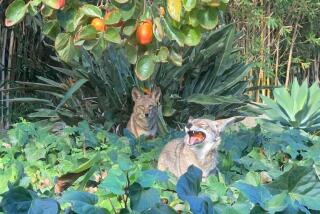Coots--Feathered Variety--Draw Curses, Gunfire in Orange County
- Share via
William M. Schwartz has a million-dollar view from his Lake Mission Viejo Assn. office window.
But the other day, Schwartz, who is the general manager of the association, looked out the window with a pained, agonized expression. He was looking at coots, the scores of small black waterfowl paddling around Lake Mission Viejo.
“Basically, the coots defecate all over everything. . . . Coots hurt the lake. They hurt the landscaping because they eat the grass and the seeds. They’re a real problem.”
Problem or no, they won’t go away, for it’s coot season in Orange County.
From the cold climes of Canada, the dark-colored water birds have been flying in to spend the winter in sunny Southern California. Palm Springs is usually too hot and dry, but Orange County is just right. They especially like the man-made lakes that decorate expensive subdivisions and country clubs in Orange County.
The love affair, however, is not mutual.
“Many associations like ours have to spend a lot of money to try to repair all the damage they cause,” Schwartz said. “Our lake is one that people swim in, so we’re real, real concerned about water quality.
“What the coots do basically is add nutrients to the lake. The nutrients deplete the oxygen in the lake, and this hurts the ecosystem of the aquatic chain in the lake. Everything suffers.”
To try to bring nature back in balance, the Lake Mission Viejo Assn. has a federal permit to shoot the water fowl.
“It varies as to how often we go out (on shooting expeditions),” said Schwartz. “From once a month to every three weeks. We use shotguns.”
Up to 100 birds can be dispatched in one expedition, but more return to fill the depleted ranks.
The reaction of Mission Viejo residents to the bird killing is “both pro and con,” Schwartz said.
“The people around the lake really understand the problem and know why this has to be done,” he said.
But sometimes other residents question doing in the coots. Rather than looking fierce or threatening, coots can look downright lovable. With white beaks, red eyes and black feathers, they have a humorous appearance. A coot-covered lake looks something like a Daffy Duck convention.
o Coots are not ducks, however. According to the World Book Encyclopedia, coots are also called mud hens and are members of the rail family. “The saying ‘silly as a coot’ probably comes from the bird’s clumsiness,” the encyclopedia says.
But the coot’s clumsiness ends when it gets into the water. There it looks like an Olympic champ as it darts underwater or body-surfs on lake waves.
Occasionally, the birds become agitated and sound off, emitting a honking, screeching noise that resembles that of an adolescent boy whose voice is changing.
The messy habits of the birds, however, are chiefly what makes them social pariahs in many Orange County subdivisions.
At the Lake Forest Community Assn. in south Orange County, coots are blamed for the guano-splattered boardwalk by the lake. “See all this mess?” grimaced Jeff Horn, community relations director for the association. “ This is what coots do. They also pollute the lake.”
The Lake Forest association, however, has not declared war on the coots. Residents have just tried to live with the uninvited visitors, Horn said.
According to the National Audubon Society, coots migrate to Southern California from the plains states and parts of Canada. Officials at the society said the birds arrive in Orange County in October and remain until March or April.
“Coots can be found any place where turf and water are together,” said Pete Butchko, a supervisor for the U.S. Department of Agriculture and Damage Control in Visalia.
Grass and plant life are staples in the birds’ diet, so coots often congregate on golf courses, wildlife officials said. They dig their beaks into the greens, leaving large holes. Their droppings also kill some plants.
“They are messy when they decide to relieve themselves,” said Louis Izurieta, manager of the Santa Ana Country Club.
The Santa Ana Country Club--like many other golf clubs in Southern California--has obtained a permit allowing the club to shoot the coots. Butchko said he approved about 50 permits to kill coots in Southern California last year, most going to golf courses.
Wildlife officials said that killing coots does not hurt their population, because they “multiply like rabbits,” but some still question the wisdom of shooting them to alleviate the problem.
“You just don’t like people out there killing animals because they want to get rid of them or because they’re a nuisance,” said John Borneman, a spokesman for the National Audubon Society in Sacramento.
“It’s a shame that this takes place every year. People haven’t learned how to live with the cycles of wildlife.”
But those trying to cope with the coot at Orange County lakes say the little bird is a big pain.
“We wish all these coots would be gone,” said Horn, as he stood on the dung-splattered boardwalk at Lake Forest. “They cause a problem for everybody’s docks. They just make a mess of things.”
More to Read
Sign up for Essential California
The most important California stories and recommendations in your inbox every morning.
You may occasionally receive promotional content from the Los Angeles Times.










